A Private Tour in the Brecks today, it was to be a relaxed paced day, though that would not hinder us in any way. By 9am, the sun was shining and there was wall to wall blue sky overhead, a glorious day to be out birding.
Our first destination was to be Drymere and Cockley Cley, with Great Grey Shrike and some of the other breeding birds of the forest clearings our targets. As we walked down the ride from the car park, we spotted a pair of Yellowhammers in a small oak tree ahead of us. They dropped down to the ground and started feeding in the long grass and were seemingly unconcerned as we walked right past.
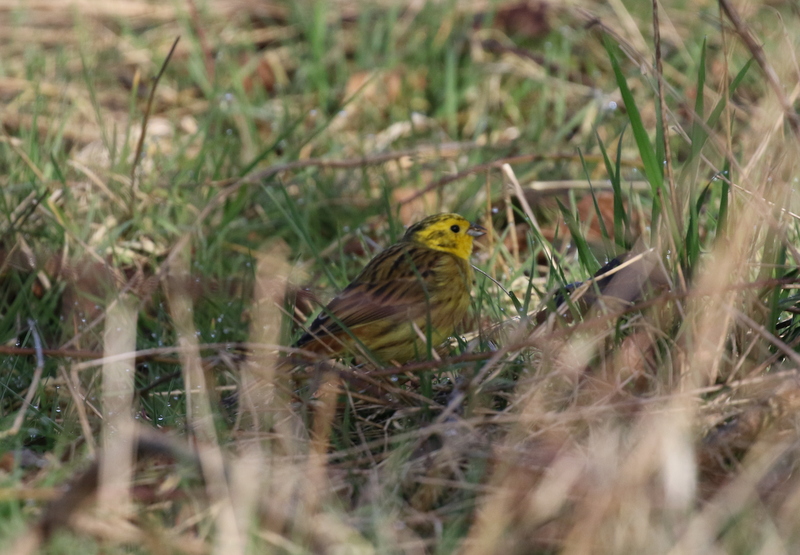 Yellowhammer – the bright yellow-headed male
Yellowhammer – the bright yellow-headed male
We walked on a little further along one of the rides, hoping we might bump into a Woodlark, but at first we couldn’t hear any. Then, as we turned to walk back, one flew up from the clearing and began singing its beautiful but rather melancholy song. It hovered up into the air and started to fly round high above the ground. A second Woodlark appeared too, from roughly where the first had come, and flew up into a small tree on the edge of the path. We got it in the scope and had a great look at it, noting the rusty cheeks and striking pale supercilium.
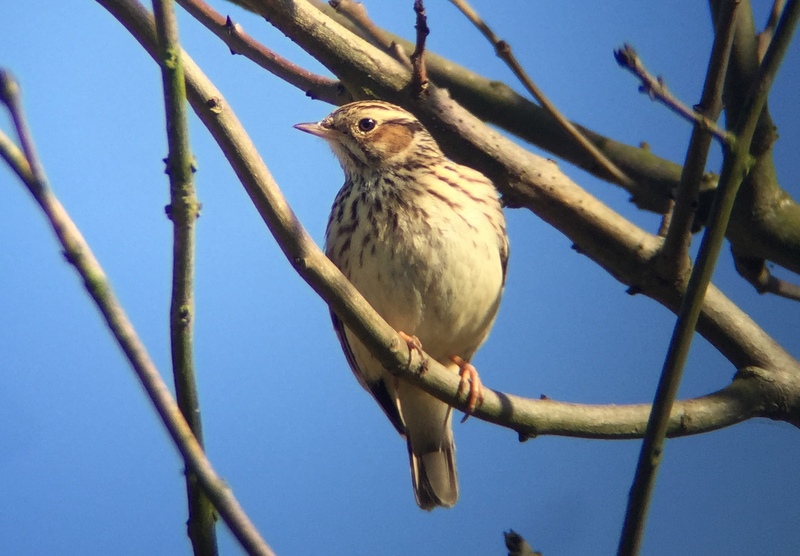 Woodlark – started singing from its perch up in a small tree
Woodlark – started singing from its perch up in a small tree
At first we thought the second bird might be a female Woodlark, the two having flown up from the same spot, but then it started singing quietly too. It is a real sound of early spring in the forest, listening to the Woodlarks singing in the clearings. As we made our way back to the main ride, a Tawny Owl hooted from deep in a conifer plantation – we have heard a couple of daytime hooters in here in recent days.
The Great Grey Shrike had been favouring a young plantation further down, but when we got there we couldn’t find any sign of it. After a quick look round, we bumped into another couple of birders who told us it had been there earlier, but had been flushed by a dogwalker and flown off. We decided to try our luck elsewhere.
We made our way round to another clearing where we thought there was a chance the shrike might be. As we walked up along the path, we heard a distinctive ringing song from the plantation alongside. It was a Willow Tit, a very scarce bird these days. We hoped it might come out onto the edge but it remained deep in the trees. Unfortunately only a Coal Tit emerged into the sunshine. We listened to the Willow Tit for a while, before turning our attention back to the clearing.
There was no sign of the shrike here either, but looking up into the blue sky and we spotted a Goshawk in the distance, flying towards us. It was getting warm now, with bright sunshine and light winds, and the Goshawk gained height quickly. We noticed a couple of Common Buzzards above it first, then more raptors higher up still. On closer inspection, there were five Goshawks with the Buzzards, all circling together! It is quite a rare occurrence to see quite so many all at once, so we were very pleased but they were high and some distance away, so it was hard to make out much detail.
Fortunately, the next thing we knew we heard a Goshawk calling and an adult male circled up slowly above the trees, much closer to us. It was in no hurry, lurking behind the tops for several minutes before it finally gained height. We could even get it in the scope, noting its clean grey upperparts and striking white underneath. As it circled higher, it alternately disappeared against the blue sky and then flashed white as it turned towards us.
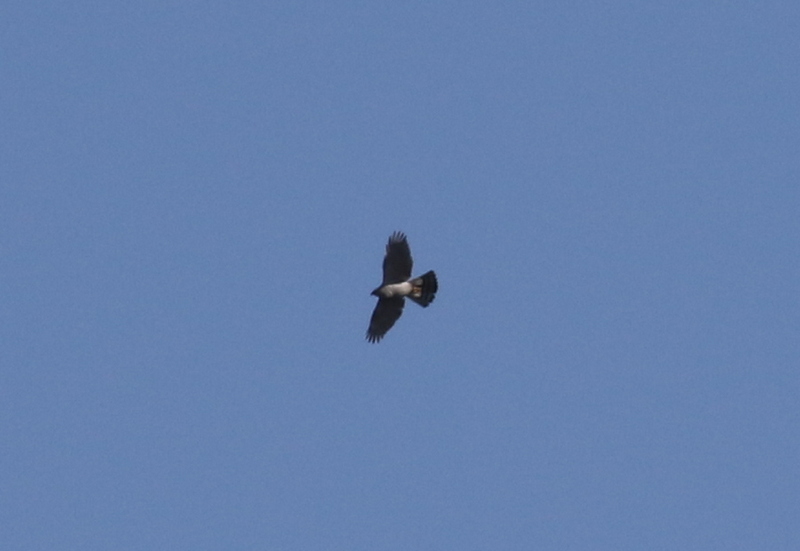 Goshawk – a male circled up out of the trees calling
Goshawk – a male circled up out of the trees calling
We lost sight of it as it went higher but, when we heard it calling again, we looked across to see a second Goshawk with it. This was a young bird, a juvenile born last year, with peachy orange tinged underparts and darker brown above. The juvenile female, bigger than the male, was displaying, flying across over the trees with very deep, exaggerated wingbeats. The adult male Goshawk then responded, calling again and doing a burst of rollercoaster display, closing its wings and swooping down before turning up sharply again, repeating this three or four times, losing height all the time back down towards the trees.
That would have been good enough, but we were in for a further treat. The male Goshawk then appeared again, even closer, slow flapping out from the trees and over the ride ahead of us with his white undertail coverts puffed out. The reason soon became clear, as we noticed the big juvenile female Goshawk was circling away to our left over a young plantation. Our view was obscured at first by some trees, but walking quickly forwards we had clear views as she circled overhead for a couple of minutes, gradually drifting further back. Fantastic views and a real treat to see one up so close!
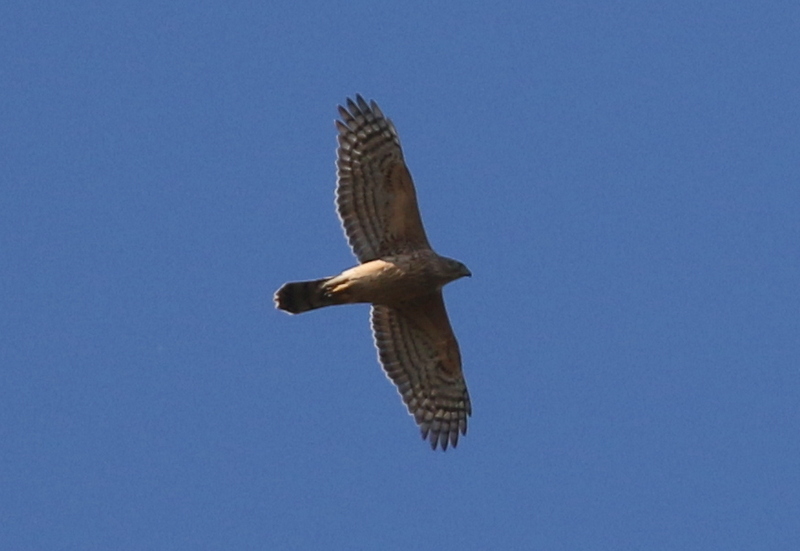 Goshawk – this juvenile female circled overhead for a couple of minutes
Goshawk – this juvenile female circled overhead for a couple of minutes
Eventually, we had to tear ourselves away from the Goshawks and make our way back. On the way, we saw several butterflies out in the spring sunshine, Comma, Brimstone, Small Tortoiseshell and Peacock (we would also add Red Admiral to the list later, at Lynford). Several Chiffchaffs were singing from the young plantations – they have arrived back in numbers in the past few days and are busy establishing territories. As we walked along beside a block of mature trees, we could hear the cones crackling in the heat, as they opened and dropped their seeds.
The Great Grey Shrike has been favouring a couple of different areas in recent days, so with it having been disturbed from one, we thought we would take a look at the other. As soon as we walked along the ride and out through the trees, we could see a white shape sat right on the top of a bush in the clearing, even with the naked eye. There was the shrike! It flew across and landed on a young oak tree by the path.
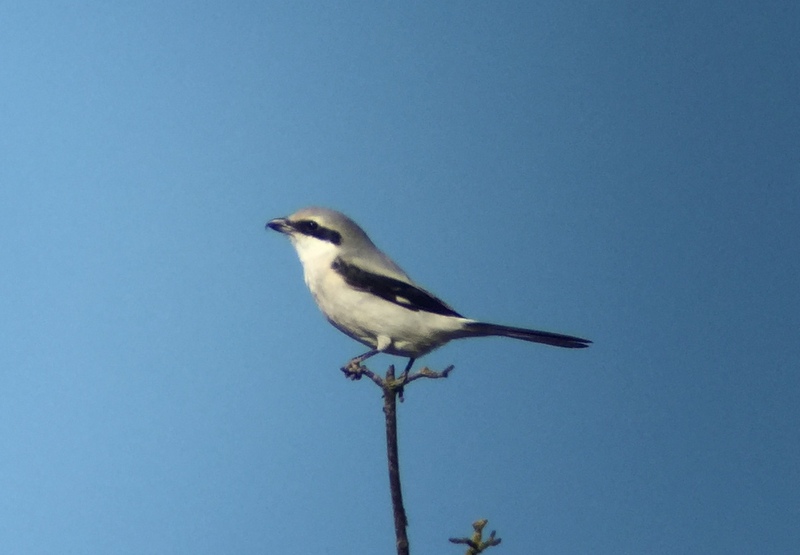 Great Grey Shrike – still in one of its favoured clearings at Cockley Cley
Great Grey Shrike – still in one of its favoured clearings at Cockley Cley
We got the Great Grey Shrike in the scope and had a good look at it. It was not too far away, but we didn’t want to disturb it by trying to get too close, as some others have been doing in recent days. However, while we were watching it, a couple of walkers came down the ride behind us and continued straight on past, despite us obviously looking at something along the path. As they got close to the tree, the Great Grey Shrike was off, in a bounding flight. Fortunately, it came towards us and landed much closer. Now we had really a great view here – we could even see the hooked tip to its bill.
When the Great Grey Shrike flew again, we decided to leave it in peace and make our way back to the car. Having enjoyed such fantastic views of Goshawk here, we now didn’t need to go and look for them elsewhere, so we decided to head over to the RSPB Reserve at Lakenheath Fen. We wouldn’t have time to explore the whole reserve today, but it would be a nice place to have lunch and use the facilities. In fact, it was just about lunchtime when we arrived so we stopped for a bite to eat, enjoying the sunshine on the picnic tables outside today.
 Reed Bunting – in the sallows by the feeders, waiting to come in
Reed Bunting – in the sallows by the feeders, waiting to come in
After lunch, we walked up to the visitor centre and out towards the Washland viewpoint. There were several Reed Buntings still coming in to the seed on the bird tables by the visitor centre, but not so many other birds here today. There has been a pair of Garganey on Hockwold Washes in recent days, which we hoped to see. We were told that they were asleep on one edge, but we hadn’t been up at the Washland viewpoint long when a patrol boat came along the river and flushed a lot of the ducks. A couple of Water Pipits flew up from the bank too, calling, but they were hard to get onto as they landed again quickly.
All the ducks flew round and thankfully landed back on the water again. It didn’t take us long to find the pair of Garganey, out in the middle of Washes, the drake giving himself away with his bright white eye stripe catching the sun. They were feeding actively, upending constantly, but they swam steadily back towards us as they did so. We could now see the ornate, elongated scapulars hanging down over the drake’s flanks.
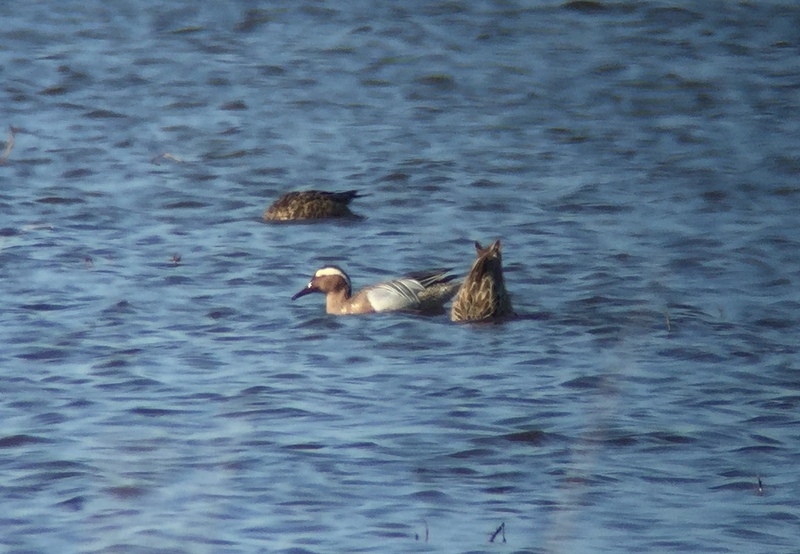 Garganey – this pair were on Hockwold Washes again today
Garganey – this pair were on Hockwold Washes again today
There were plenty of other ducks here too. A party of Wigeon were whistling, the drakes with the creamy yellow stripe up the front of their heads. There were lots of tiny Teal and shovel-billed Shoveler. Several Tufted Ducks and Pochard were busy diving and a pair of Shelduck dropped in. The rather dull coloured Gadwall were in danger of being overlooked – we got them in the scope but unfortunately they were too far away to appreciate their true beauty! The Washland provided a pleasant post-lunch stroll, but we wanted to spend the afternoon at Lynford Arboretum. So, with time pressing, we headed back to the car park.
When we arrived at Lynford, we made our way over the road and up along the path. Several Siskins were feeding in the larches, taking advantage of all the cones popping today to help themselves to some seeds. We could hear Goldcrests singing and watched as one flew across between the trees.
At the feeders, we were told that a couple of Hawfinches had been seen down on the ground earlier, but had been disturbed by the ubiquitous Grey Squirrels! We stopped for a scan anyway, to see what was there. A Nuthatch kept dropping in down on the ground and a steady stream of tits came in to the feeders and fat balls.
We could hear Hawfinches calling from the trees beyond, so we made our way along a little further and looked back into the tops. However, while we were scanning for activity, a quad bike came out of the trees and round on the path past the chicken run. It spooked a single Hawfinch from the trees, but that flew off across the clearing and disappeared deep into the plantation at the back, before anyone could get onto it.
The Hawfinches went quiet for a bit after that disturbance. We went back to the feeders, and contented ourselves with watching the Bramblings. A few were feeding in the leaf litter on the ground but several kept returning to the same couple of branches a few metres up in the Beech trees. Through the scope, we could see that the branches were wet with sap and on one we could even see three fresh, small holes in the bark. The Bramblings were drinking the sap, either wiping their bills sideways on the wet bark or supping it directly from the holes. This is not something which is often recorded, so it was great to be able to watch it.
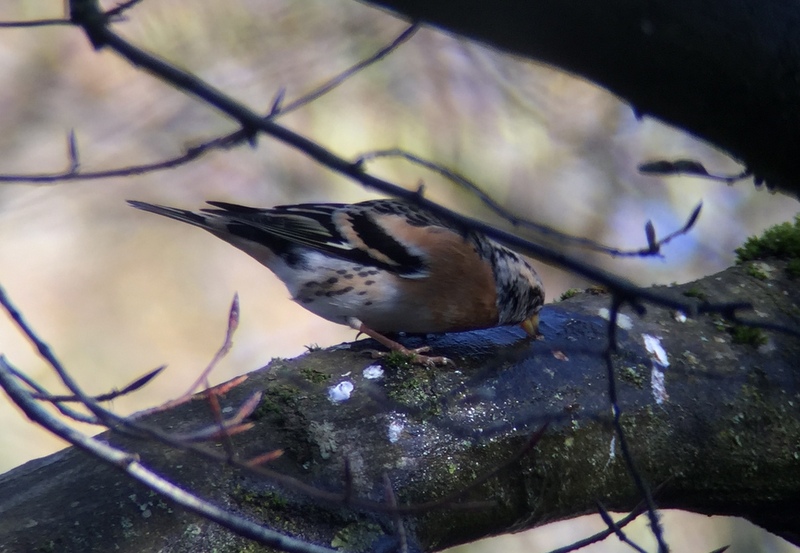 Brambling – drinking sap from holes in the bark of a beech tree
Brambling – drinking sap from holes in the bark of a beech tree
While we were standing by the feeders, we heard a Firecrest calling behind us. We walked over into the Arboretum and found it flitting around in a small holly tree. Unfortunately, it was moving so fast it was hard for everyone to get a good look at it. It came out on to the edge briefly, but disappeared straight back in. It sang once briefly but then quickly flew back into the fir trees behind and went quiet.
Fortunately, the Hawfinch activity resumed shortly afterwards. Someone spotted two fly in to the trees at the back of the chicken run clearing. The birds landed deep in the trees, but thankfully with their help we were able to get one of them in the scope, a grey brown female, but still sporting a massive nutcracker of a bill. They didn’t stay for very long, but when they flew again they were accompanied by another four, the six Hawfinches all flying off towards the bridge.
 Hawfinch – this female perched up obligingly in the top of the Beech trees
Hawfinch – this female perched up obligingly in the top of the Beech trees
Despite the mass exodus, we could still hear the electric ‘ticking’ call of more Hawfinches in the trees and then another two females appeared high in the beeches above the feeders. This was a much better view, with one perched obligingly in the open, framed by the opening buds. After a few minutes they flew off too, but we could still hear ‘ticking’ from the trees.
We walked back towards the feeders to see if we could possibly find one down on the ground, but then heard ‘ticking’ from the Arboretum side of the path. We looked across to see a male Hawfinch perched high in the top of a fir tree. It was silhouetted against the sun at first, but we made sure we had a good look at it in case it flew off. Then we made our way quickly round through the Arboretum to the other side of the fir tree. Thankfully, it stayed perched up in the top, clambering around in the thin branches, calling constantly.
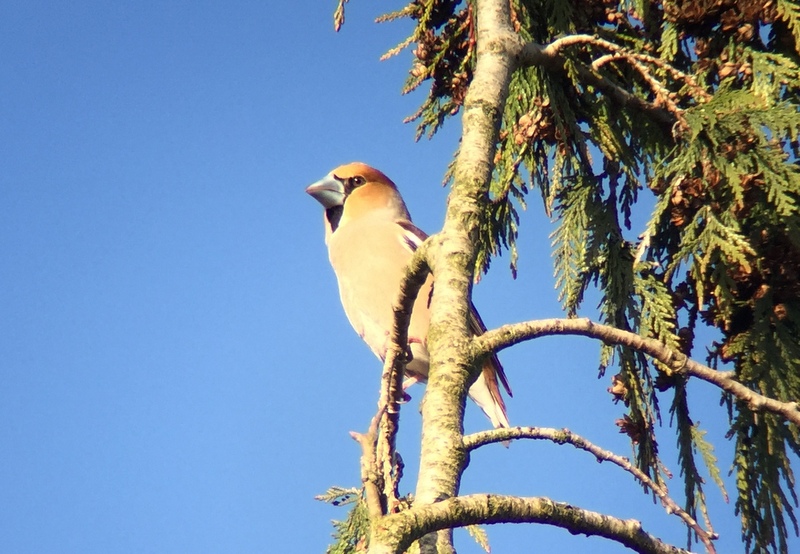 Hawfinch – a brighter male, perched in the top of a fir tree
Hawfinch – a brighter male, perched in the top of a fir tree
The Hawfinch seemed to be enjoying the afternoon sunshine from high up on its perch. From this angle, we could see it was much more richly coloured than the female, with russet tones around the face and crown and a contrasting grey nape. A very smart bird! We watched it for some time before eventually it dropped down further into the Arboretum, out of view. We took that as a cue to move on down to the paddocks.
Down at the bridge, we were hoping to find some Common Crossbills coming down to drink. As we arrived, we could hear Crossbills calling, but the six of them flew out and disappeared away over the pines before we could get round and into position. Thankfully, we didn’t have to wait too long before another pair flew in and landed high in the poplars. A bright red male was accompanied by a grey-green female. They perched high up in the branches for a few minutes before flying across into the young pines.
That was great, at least we had seen some Crossbills, but given how they have been performing here recently, we rather fancied a closer look. We walked down to the pines to see if we could find any feeding in here, but the cones here too were cracking in the heat and falling off the trees naturally, which meant we wouldn’t be able to hear where any Crossbills were feeding. We had a look anyway, but couldn’t find any in the trees they have been favouring.
There were three Marsh Tits chasing each other through the bushes along the edge of the paddocks, and we walked round to have a look at the Long-tailed Tit’s nest, which has made quite a bit of progress since yesterday and looks almost finished now.
 Long-tailed Tit’s nest – made considerable progress since yesterday afternoon
Long-tailed Tit’s nest – made considerable progress since yesterday afternoon
As we walked back, we heard Crossbills calling back at the bridge and when we got there we could see four up in the poplars now. There were two rather dull rusty males, not bright red like we had seen earlier, and what appeared at first to be a grey-green female next to them. When she finished preening, we could see that she was actually quite an advanced juvenile, with considerable patches of new feathering, but still some streaks on her flanks. A rather brown and streaky fresh juvenile Crossbill was nearby for comparison.
The views here were better than we had enjoyed earlier and the Crossbills stayed in the trees for some time, the older birds preening and the fresh juvenile clambering around eating leaf buds. Eventually, they flew off towards the pines and we made our way back to the bridge. We stood here for a while, watching the various birds coming and going from the seed put out for them. A Marsh Tit darted in a couple of times and a Nuthatch tried its luck on one of the wooden posts further back. There was a steady stream of Long-tailed Tits and Blue Tits too, and a single Reed Bunting.
 Long-tailed Tit – coming down to the seed at the bridge
Long-tailed Tit – coming down to the seed at the bridge
While we were watching all the other birds coming to the seed, we heard a Crossbill calling and saw it land in the alders nearby. It was a very smart, bright red male, but just as we were getting the scope on it, it flew again, but came straight towards us and landed above our heads. Here it perched for a while in the sun, singing. Stunning views!
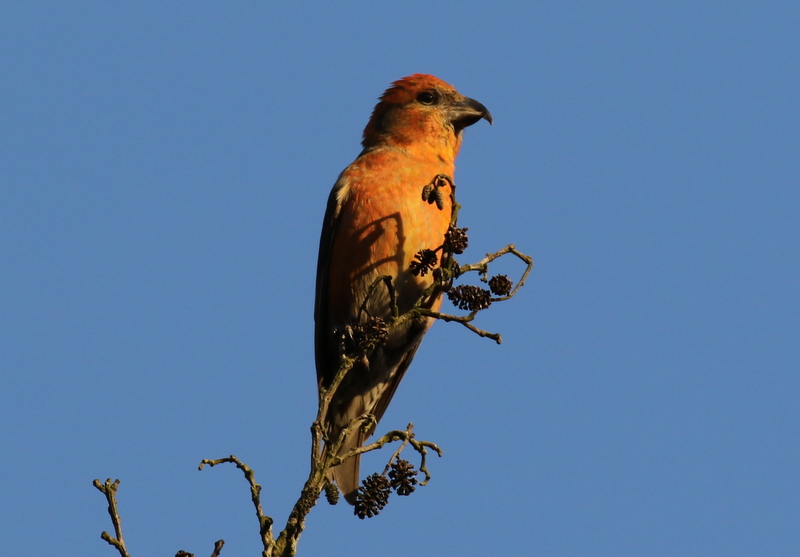 Common Crossbill – this bright red male perched above us singing
Common Crossbill – this bright red male perched above us singing
When the male Crossbill flew again, it was followed by a female which we hadn’t noticed arrive with him. The two of them dropped down to drink at a puddle nearby, before flying back up and chasing each other off through the trees. It was getting late now, so we thought that would be a nice way to end the day, and started to make our way back.
When we got to the car park, we were just loading up the car when we heard a crest calling from somewhere high in the fir trees. We walked round to where we could hear it better and sure enough it was a Firecrest, as we thought. We looked right up to the treetops, where the last of the afternoon sun was just catching the highest branches, and we could see it flitting around. There were lots of small flies up there, buzzing around the tree, and it kept flycatching into them. We could just make out its distinctive black and white striped face. The Firecrest sang briefly, then it disappeared back into the trees and we resumed our packing up and departed for the journey home.
What a glorious day in the Brecks it had been, with such fantastic views of so many of our local specialities.
















